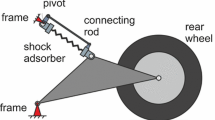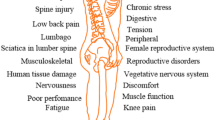Abstract
To achieve better cycling performance and vibration comfort of mountain bicycle, the optimization of frame structural parameters and rear suspension scale parameters is investigated based on biomechanics. Firstly, the quadratic sum of rider lower limb muscles stresses is presented as the evaluation criterion of muscle fatigue. By taking the criterion as the objective function, the relative positions of three pivot points of frame are optimized to ensure that the frame structural parameters match the stature of riders. Secondly, the vibration performance is evaluated referring to the ISO 2631-1 Mechanical Vibration and Shock Evaluation of Human Exposure to Whole-Body Vibration. According to this evaluation, the mapping relationship between the vibration performance and rider’s weight as well as structural parameters of rear suspension is revealed. Results show that the length of side link has no significant effect on vibration comfort, while rider’s weight is important in the design of mountain bicycle.
Similar content being viewed by others
References
Chinese Bicycle Institute. Bicycle produce and sale quantity from January to August in 2006[J]. China Bicycle, 2006(10): 19(in Chinese).
Huang Haibo, Ding Yulan. Ergonomic design of bicycle saddle[J]. Journal of Engineering Graphics, 2005, 26(3): 106–119(in Chinese).
Zheng Xiaohong. Preliminary Study of China Outstanding Track Cycling Female Athletes Pedaling Mode[D]. Beijing Sport University, Beijing, 1997(in Chinese).
Baum B S, Li L. Lower extremity muscle activities during cycling are influenced by load and frequency[J]. Journal of Electromyography and Kinesiology, 2003, 13(2): 181–190.
Wilczynski H, Hull M L. Dynamic system model for estimating surface-induced frame loads during off-road cycling[J]. Transactions of the ASME, Journal of Mechanical Design, 1994, 116(3): 816–822.
Wang E L, Hull M L. Power dissipated by off-road bicycle suspension systems[J]. Journal of Cycling Science, 1994, (4): 10–13, 26.
Wang E L, Hull M L. A dynamic system model of an offroad cyclist[J]. Journal of Biomechanical Engineering, 1997, 119(3): 248–253.
Redfield R C. Extreme mountain biking dynamics: Development of a bond graph model[C]. In: Proceedings of the IASTED International Conference Modeling and Simulation. Anaheim, CA, USA, 2003. 450–455.
Redfield R C. Planar, large excursion bond graph model for full suspension mountain biking[C]. In: Proceedings of the ASME Dynamic Systems and Control Division. Orlando, FL, USA, 2005. 1157–1167.
Waechter M, Riess F, Zacharias N. A multi-body model for the simulation of bicycle suspension systems [J]. Journal of Vehicle System Dynamics, 2002, 37(1): 3–28.
Chen Cizhang, Chen Junsheng, Sun Zhengwei et al. Comfort Analysis and Parameter Design for Scooter Riding[EB/OL]. 2005-11-01. http://www.mscsoftware.com.tw/training_support/support/VPD_2005/final-mech3.pdf (in Chinese).
Meng Jie, Zhao Dongxu, Zhao Yijia. Numerical simulation analysis of mountain biking lower extremity motion[C]. In: Proceedings of National Sports Equipments and Sports System Simulation. Hangzhou, China, 2006. 227–232(in Chinese).
Bu Yan, Xiang Zhongxia, Huang Tian. A multi-body model for the simulation of rider and mountain bike coupled system [C]. In: Proceedings of the 7th World Congress on Intelligent Control and Automation. Chongqing, China, 2008. 1669–1672.
Crowninshield R D, Brand R A. A physiologically based criterion of muscle force prediction in locomotion[J]. Journal of Biomechanics, 1981, 14(11): 793–801.
Xu Li, Guo Qiao, Chen Haiying. Optimum solution and analysis of redundant muscular force in lower extremity during running[J]. Journal of Beijing Institute of Technology, 2004, 24(10): 869–873(in Chinese).
LifeMOD Manual [M/CD]. Biomechanics Research Group, California, 2005.
Ding Yulan. Human Engineering[M]. Press of Beijing Institute of Technology, Beijing, 2000(in Chinese).
Zhou Yiming, Mao Enrong. Human Engineering of Vehicle[M]. Press of Beijing Institute of Technology, Beijing, 1999(in Chinese).
Zhang Naying. Application of human engineering in bicycle design[J]. China Bicycle, 2001(1): 25–29(in Chinese).
Xiang Z X, Bu Y, Zhang Y H et al. Vibrant comfort-based parameterization for mountain bike rear suspension[J]. Journal of Tianjin University, 2008, 41(6): 685–689.
International Organization for Standardization. ISO 2631-1:1997(E) Mechanical Vibration and Shock Evaluation of Human Exposure to Whole-Body Vibration (Part 1): General Requirements[S]. International Organization for Standardization, Switzerland, 1997.
Author information
Authors and Affiliations
Corresponding author
Additional information
Supported by Tianjin Science and Technology Development Project (No.043186211) and Tianjin Key Laboratory of Advanced Manufacturing Technology and Equipment.
BU Yan, born in 1979, female, Dr.
Rights and permissions
About this article
Cite this article
Bu, Y., Huang, T., Xiang, Z. et al. Optimal design of mountain bicycle based on biomechanics. Trans. Tianjin Univ. 16, 45–49 (2010). https://doi.org/10.1007/s12209-010-0009-2
Accepted:
Published:
Issue Date:
DOI: https://doi.org/10.1007/s12209-010-0009-2




